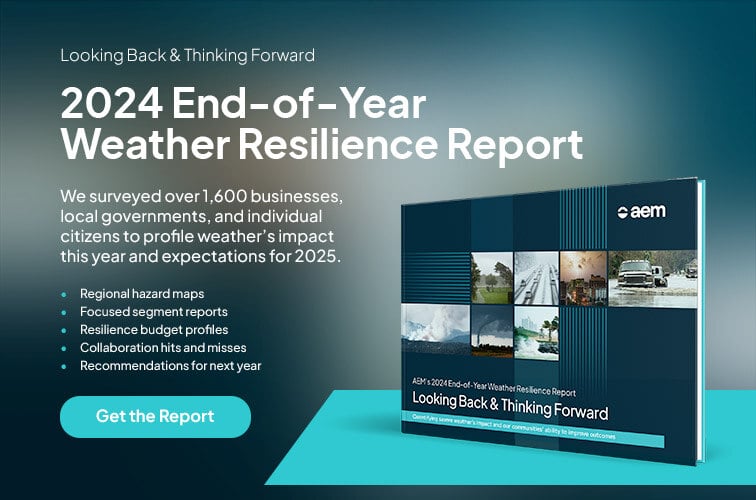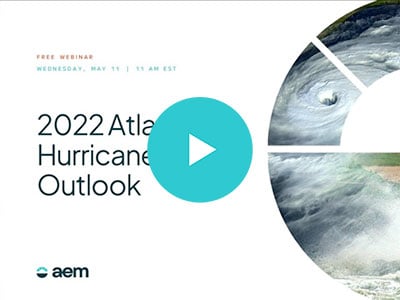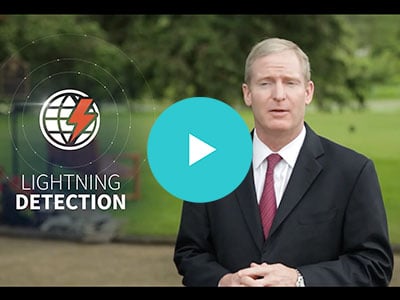
At AEM, our purpose is to empower communities and organizations to survive – and thrive – in the face of escalating environmental risks. Dangerous weather is becoming more common and more severe across the globe, making weather risk management one of today’s biggest and most relevant challenges.
In this article, we'll...
- Define severe weather risk management
- Explore which kinds of weather are most threatening or dangerous
- Present the case for weather risk management in a variety of industries
- Provide a sky-high view of severe weather risk management solution configuration
What is severe weather risk management?
Severe weather risk management is the practice of proactively planning for dangerous weather events and leveraging technologies that maximize your ability to forecast threatening systems, monitor conditions as they develop, and execute response and communication plans as quickly as possible to keep people safe.
Why is weather risk management important?
Dangerous weather can kill or injure people. Whether you’re a business with employees, a municipality with citizens, or a school with students, you need to keep your people – and by extension the people they interact with – safe.
Public Safety
The destructive potential of the weather cannot be understated. According to the National Weather Service, there were 776 weather-related fatalities in the U.S. alone in 2021, up 53% over the ten-year averages.
Even though no person or business can control the weather, it’s crucial for those who are responsible for people’s day-to-day physical safety to take the weather into account. When members of the public are harmed by weather on your watch, it can lead to liabilities, damage to your reputation, and the erosion of your community.
Protecting Infrastructure
Human life is always priority number one when it comes to safety, but it’s also crucial to minimize the destructive impact of the weather on buildings, utility infrastructure, roadways, bridges, dams, and beyond.
Weather damage to infrastructure often leads directly to public safety issues, from traffic pileups and long blackouts to job losses and unhoused families. The human and monetary costs of weather’s impact on our infrastructure cannot be underestimated.
Why it’s more relevant than ever
Two words: climate change. The average global temperature is rising, and large-scale severe weather events are becoming more common.
Climate and, by extension, weather are the major challenges of our lifetime. Our whole concept of what is “normal,” what is “unseasonable,” and what is a “freak” weather event are all being challenged right now, and as far as we can see, the danger level will only continue to rise.
What kind of weather events need to be prepared for?
Specific weather challenges vary based on regionality and time of year, but generally speaking, these are the severe weather risks that businesses and governments should be prepared for:
Hurricanes & Tropical Storms
Hurricanes and tropical cyclones pack an impressive combination of severe weather risks: high winds, lightning strikes, and torrential rainfall, just to name a few. Working together, those factors can cause further tragedies, such as floods, fires, and destruction of infrastructure.
Hurricanes and cyclones have historically followed predictable cycles and paths, but changes in water and air temperature around the world are rewriting the rulebook on many of our assumptions about tropical storms. All signs point to storms getting bigger, more frequent, and more destructive.
Winter Storms
Although they don’t get the same press as their summertime cousins, winter cyclones can also be extremely powerful and dangerous. Bomb cyclones and polar vortices can drop feet of snow while packing a combination of low temperatures and arctic winds that can make conditions outside downright dangerous for anybody.
High Winds
Even in the absence of precipitation, wind can be extremely damaging. As weather gets generally more intense around the globe, ensuring buildings, work sites, and utility infrastructure can withstand the increasingly changing conditions is a growing area of concern and focus.
Lightning
Lightning can be delivered by many different kinds of storm systems at any point throughout the calendar year. Like a major storm, lightning presents both direct and downstream safety challenges.
In 2021, 445 million total lightning pulses in the U.S. alone, with more than 35.5 million cloud-to-ground strikes.
Lightning strikes to individuals are very dangerous and potentially deadly. Strikes to older buildings or dry land (more common thanks to rising temperatures) can start aggressive fires. Strikes to utility infrastructure can cause significant power outages while also sparking fires.
High & Low Temperatures
High temperatures can cause exhaustion, difficulty breathing, dehydration, sunstroke, nausea, vomiting, and unconsciousness. Temperatures are generally rising, and the number of exceptionally hot days each summer is also on the increase.
Cold temperatures, on the other hand, can cause hypothermia, frostbite, reduced blood flow, and mental disorientation. In areas with long, cold winters or where winter recreation is popular, cold temperature exposures can have disastrous consequences.
Floods
Floods are on the rise globally and have the potential to disrupt daily life, destroy infrastructure, and render normally safe roadways incredibly dangerous. According to a report by the University of Melbourne, flood risk will rise 50 percent around the world in the next 80 years.
Given the increased stakes, Flood Risk Management is a critical growing field that seeks to combine weather monitoring technologies, hydrometrics, and communication technology to identify flood risks before they occur and protect the public with maximum transparency about flood locations, durations, and evacuations/road closures. This approach addresses flood preparedness, response, and resilience to address the entire event curve.
Wildfires
Like floods, wildfires are on the rise globally due to both climate change and human factors. Whether they’re started by lightning, human action, or any other source, wildfires are highly destructive to natural resources, increase flood risks in affected areas, and can be deadly to both animals and humans.
In recent years, utilities and local governments have had to work together more closely than ever before to monitor wildfire risks in the wildlife-urban interface area (WUI), where bushfires can have serious resource management and public safety implications. In a growing number of areas across the world (not just California, Arizona, and Australia), wildfire risk management and resilience will be key to protecting our communities’ sense of normalcy as well as our natural resources.
Road Weather
We’ve talked a lot about how weather adversely affects our infrastructure and sense of daily normalcy, and roadways are a prime example of that. When roads are wet or icy due to precipitation, flooding, or some sort of a spill/accident, it can bring the routines of millions of people to a screeching halt while creating a variety of personal and public safety challenges.
When serious weather affects the roadways, municipalities and state/local response agencies need to be able to communicate with the public about the location and severity of risks without creating additional potential hazards. Road weather technologies provide the framework for a highly automated response that keeps drivers and emergency response professionals as safe as possible while providing as much data as possible about live conditions in the field to assist additional response planning.
Who needs a severe weather strategy?
Generally speaking, any organization that’s responsible for people’s physical safety (employees, students, etc.) needs to have a severe weather risk management and response strategy in place.
Over the years, however, we’ve found severe weather monitoring is most relevant in the following industries:
Utilities
Utilities come in all sizes and shapes, from large investor-owned utilities to rural electric co-operatives, but all utility operations can be negatively impacted by the weather. For energy providers, power lines, high-tension towers, transformers, and generation equipment are all susceptible to powerful winds.
Of course, utilities can’t just be satisfied to provide service continuity in the face of severe weather. It’s also crucial to protect employees and the public. Powerline workers carry out service in close proximity to all the dangerous equipment listed above, and much of water utility service is done in open trenches, where a sudden downpour could be deadly.
A utility cannot be truly dedicated to their service of their community unless they proactively plan for how they will collaborate with local government officials and response agencies to manage any sort of severe weather crisis, whether it’s a powerful storm or a wildfire.
Sports Leagues & Clubs
Outdoor sports and activities are highly dependent on amenable weather. When there’s lightning nearby or a pending storm that could arrive mid-game, sports and recreation professionals need a more accurate forecast than the local newspaper, TV station, or public weather site can provide to make decisions.
This challenge affects sports at every level, from town rec leagues to private sports clubs and even top-level professional competition. In fact, as the scale of the operations get bigger, the stakes get higher. In the case of cancelling a town soccer game, only a few dozen people are affected, but when you postpone a baseball game with an expected attendance of 30,000 fans and thousands more employees on site, that’s a big, expensive decision. That’s why sports teams and leagues are partnering with private weather service providers more than ever before.
Airports and Airlines
Most people who travel with any regularity have a story about the weather affecting their trip to the airport. That’s because airports are one of the most high-stakes locations when it comes to weather risk management in the name of public safety.
Airports process tens of thousands of daily visitors, including travelers and drivers. Keeping the public safe requires a wide range of weather monitoring tools, as an airport acts in some ways like a small city. There are roadways, therefore road weather is a concern. There may be dams or levees on site at coastal airports that require monitoring in the event of a storm or flood. And, of course, that runway needs to be in safe condition for planes to take off and land.
Of course, airports and airlines also employ massive teams of luggage handlers, runway and maintenance crews, hospitality workers, and security professionals. In the case of a major weather event, such as high winds, a hurricane, a lightning storm, or a flood, all those employees, many of whom work at least partially outdoors, must be kept safe and informed about what is going on.
Farmers & Agriculture Businesses
Thanks to climate change, agriculture is becoming much more challenging, both in terms of protecting yields and maintaining worker safety. Higher temperatures make water resource and heat stress management more difficult, and increasing wildfires near agricultural regions around the world are threatening product quality and field worker health.
Environmental monitoring technologies are helping farmers fight back in a big way by providing more precision-measured data than ever before, eliminating the guesswork from agriculture and creating a schedule for watering, fertilization, and harvesting that ensures the best possible yields.
Schools & Universities
In the world of education, keeping students physically safe is the number one priority. For student-athletes and athletic personnel, that work is additionally challenging due to the travel schedule and time spent outdoors. Relevant travel alerts and on-premises sensors and alarms that tell students, athletes, and employees when to get inside are all part of that equation.
Much like an airport, a school or university campus operates like a small city. There are road weather considerations, air quality concerns, and infrastructure that needs to be protected from and monitored during adverse weather events.
Military Bases & Operations
Military bases are essentially municipalities unto themselves. There are policed roadways, parks and recreation opportunities, classrooms, and potentially airfields or naval docks. That means they face basically every single challenge we’ve already discussed above.
Given the large number of people living and working on any given military base as well as the importance and sensitivity of the work being done there, severe weather is a major operational safety consideration. By partnering with environmental service providers, miliary bases can create a personalized weather command center that creates a 360-degree view of both current and incoming weather.
Federal Government Agencies
A wide variety of government agencies are responsible for the protection of our natural resources and infrastructure. Concerns like dam safety, transportation safety, emergency resilience, and the safety of workers and researchers at far-flung sites across the country require government agencies to prioritize monitoring incoming weather, water levels, soil moisture, and beyond.
Mining Businesses
Mining operations require a strong understanding of hydrometry and a major commitment to worker safety. Environmental monitoring provides mining businesses with the tools they need to accomplish both.
By monitoring incoming weather, miners can optimize operations by calculating the exact time of an incoming storm and use that information to inform their worker management. In this way, mining businesses can maximize their productivity time while also keeping everybody safe.
Local Governments & Response Agencies
Outdoor recreation takes place every day in each city and county around the world. Some of those activities occur rain-or-shine, while others are dependent on weather and need to be confirmed or canceled in a timely manner when threatening weather develops for the sake of clarity and safety.
Municipal workers and local governments are also often the first line of response before, during, and after a weather crisis. It’s their responsibility to protect and inform their communities about what to expect, how to stay safe, and when to halt or resume normal activities.
Police, fire, and public works departments can all do their job better with a complete understanding of past, current, and future weather and road conditions. At the same time, the solutions they leverage to do their daily work can also inform long-term leadership planning with regard to public safety, urban development, and so on..
What does severe weather risk management look like?
Now that we’ve explored what severe weather risk management is, why it’s relevant, and for whom it’s most relevant, let’s start to build an understanding of what it actually looks like in action.
Having a weather risk management plan
Achieving any kind of successful management requires a plan. Any weather monitoring technologies or solutions you purchase must exist as part of an end-to-end plan that addresses the entire event curve as well as the unique challenges of your business and region.
The exact content of your plan will vary based on the factors above, but in general, you should be sure to address…
- How you’ll monitor weather
- What weather events you are monitoring for
- Which workers & members of the public could be at risk due to weather
- What activities or procedures put those people at risk
- How you’ll identify a substantial risk (what’s the threshold?)
- How you’ll communicate with people to keep them safe
- How you’ll know when the weather event is over and provide an “all-clear”
Monitoring severe weather as it develops
Weather monitoring for a specific site has two key components: an overall regional forecast that provides insights into what weather is headed your way and a hyperlocal data view that tells you the exact conditions at your business or worksite in real time.
A comprehensive weather risk management solution addresses both sets of concerns by providing reliable, high-accuracy forecasts while also building a private on-site sensor network that helps you capture and review the most relevant data for you and your team.
Knowing which weather data to track
Which weather is most relevant to you depends on your location and the nature of your work/challenges.
By working with a weather services provider, you can identify exactly what factors you’ll need to monitor, what the acceptable thresholds are, and what kind of sensors and interpretive software you’ll need to bring your ideal solution to life.
Translating weather insights into leadership decisions
With your severe weather risk management plan and your monitoring solutions in place, you have created a framework for impactful decision making in the event of a crisis. Based on what your weather data, industry research, and your own expertise, you can identify potential threats and maximize response time to protect people and resources as effectively as possible.
With your monitoring system in place, you can also harvest real-time and historical data to understand conditions in your area at a deeper level than ever before. That means that, over time, your monitoring solution won’t just help you identify and respond to weather threats, it will help you understand and plan for them better than before.
Collaborating with professional meteorologists
If you want to take your weather risk management decision making to another level, you can also collaborate with a professional meteorologist to inform your planning and help you make the most out of your weather data.
The ability to access a true weather scientist on demand takes all the guesswork out of understanding weather risks and provides your team with the best possible insights regardless of your own level of expertise. If you’re looking to lead with complete confidence during adverse weather events, be sure to partner with a service provider who has on-call meteorologists as part of their team.
Communicating with employees & the public about weather risks
Once you’ve got the right plan and the right knowledge/technology to carry it out, the final piece of the puzzle is communication. If a great weather risk management plan falls in the forest and no one is around, the rumor is that it doesn’t make a sound!
You need to understand how you’ll protect the public and your employees in direct, clear ways, such as providing them with visible weather data displays in high-traffic areas, sending mobile alerts about incoming weather, installing automated gated signage that prevents them from entering temporarily hazardous areas, and using visual/audible sirens and alarms that make it abundantly clear when hazardous weather is nearby.
Those same communication technologies should also be able to communicate a timely “all clear” message when appropriate to preserve productivity and tell people it is safe to resume normal activities.
Get the AEM Advantage
If you’ve got a severe weather risk management challenge, AEM is here to help! Our seven brands of environmental service providers are here to help you craft a custom toolkit of weather monitoring, detection, response, and communication technologies backed by our combined century-plus of experience.
No matter your industry or challenge, when you think severe weather, think AEM.








